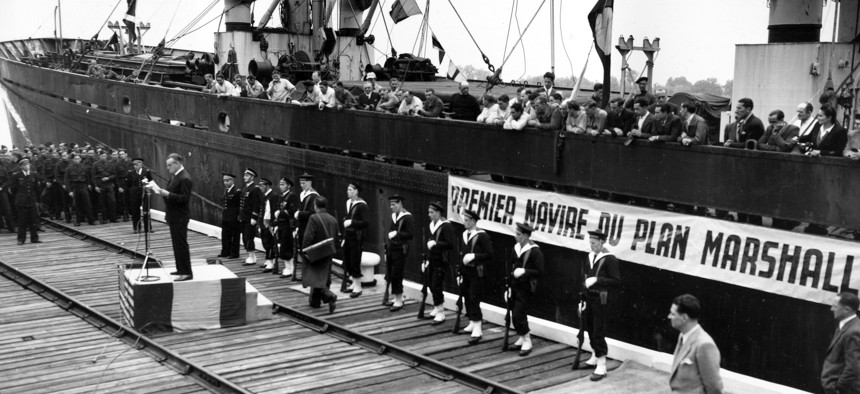
On May 10, 1948, the John H. Quick brought 8,800 tons of wheat to the port of Bordeaux, the first shipboard aid to France under the Marshall Plan. Associated Press
Why the Marshall Plan Worked — and Why It Won’t in Today’s Warzones
A host of similar-sounding yet unworkable aid schemes are among the legacies of the one that launched 70 years ago Tuesday.
The Marshall Plan—the mammoth aid scheme to revive western Europe after World War II—celebrates its 70th anniversary on April 3. And perhaps its most enduring legacy is the endless desire to repeat it.
In recent years, there have been a striking number of impassioned calls from western statesmen and celebrity philanthropists for new “Marshall Plans” around the globe: Hillary Clinton for the Arab Middle East, former German finance minister Peer Steinbrueck in southern Europe; George Soros for Ukraine; and most recently Sen. Chris Murphy for Syria. Al Gore wants one for the environment. The list goes on. As German economist Werner Abelshauser observed, “There is hardly a crisis anywhere in the world which in the view of the West ought not be solved by a sort of Marshall Plan.”
The common underlying belief in all these cases is that financial aid can bring harmony, political stability, and prosperity. But this is to misunderstand the Marshall Plan and the circumstances that made it work.
The Marshall Plan — formally, the European Recovery Program — was the first major policy component of U.S. diplomat George Kennan’s new strategy of “containing” the Soviet Union, which he outlined in an important Foreign Affairs article in 1947. The aid tendered, as a percentage of U.S. output, would be equivalent to about $800 billion today. The idea was to hasten the recovery in West European output, thereby bolstering each nation’s ability to resist Soviet subversion and the temptations of local Communist parties—which were particularly powerful in Italy and France. The Truman administration believed such a recovery would allow the United States to protect its vital political and economic interests in Europe without having to maintain millions of troops there. “The greatest danger to the security of the United States,” warned the new Central Intelligence Agency, “is the possibility of economic collapse in western Europe and the consequent accession to power of communist elements.”
The aid was to be spread over four years. This was meant to convince the recipients that the United States would not, after disbursing the funds, retreat into isolation as it had after World War I. It was also to be premised on a program, to be devised in Europe itself, for economic integration, in order to ensure that resources were used most efficiently. The State Department’s Will Clayton believed passionately that western Europe needed to look more like the United States if it wished to maximize its living standards and maintain popular support for free enterprise.
On the surface, at least, it worked. Output increased by 60 percent over the period, and the Communists were marginalized. It is important to recognize, however, that financial aid did not achieve this on its own.
The United States has spent more than $200 billion on reconstruction in Afghanistan and Iraq—or over 50 percent more than the totality of Marshall aid, in current dollars. Yet it has precious little to show for it, economically or politically. The most important reason is a lack of security. Neither country has ever achieved full control of its territory. Instead, both have been under constant siege from armed domestic and foreign opponents, such as the Taliban and ISIS. Their governments have also not been, unlike Marshall governments, natural allies of the United States, which has in turn been at odds with alternative neighboring benefactors such as Iran.
The Marshall Plan, too, would not have worked without security. In fact, the French and the British were adamant that they could not carry out the State Department’s integration vision without security guarantees from the United States. Integration meant sacrificing self-sufficiency. Being dependent on, say, coal from western Germany meant the possibility that a future Germany—perhaps under Soviet control—could throttle its economies by cutting off supply. This in turn meant an intolerable national security risk. Businesses would not invest and the economy would not recover under such a threat. They therefore persuaded the Truman administration to add, in April 1949, what the latter came to call a “military ERP”—security guarantees under a North Atlantic Treaty Organization. It was this combination of aid, integration, and security which underlay western Europe’s remarkable recovery.
In short, the foundation that enabled American economic statecraft to be so successful in post-war Europe is lacking in the cases of Iraq and Afghanistan, or Ukraine and Syria. Financial aid cannot on its own bring peace, political reform, or even economic stability. Given the insatiable desire to create new Marshall Plans around the globe, it is critical to recognize that physical security is prerequisite for economic revival.